ASM Metals HandBook Vol. 14 - Forming and Forging
Подождите немного. Документ загружается.

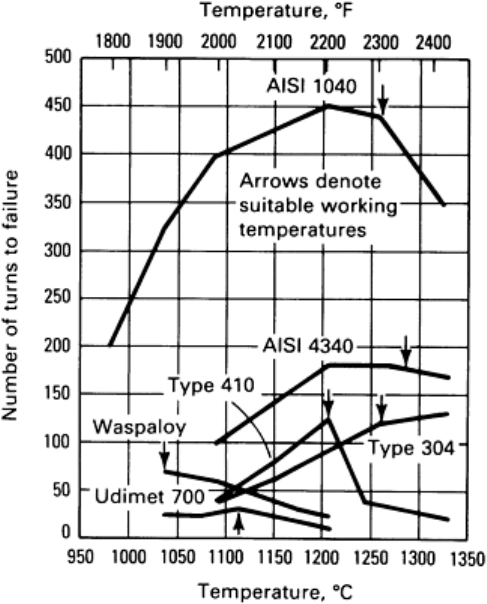
The compression test, in which a cylindrical
specimen is upset into a flat pancake, is usually
considered to be a standard bulk workability test.
The average stress state during testing is similar to
that in many bulk deformation processes, without
introducing the problems of necking (in tension) or
material reorientation (in torsion). Therefore, a
large amount of deformation can be achieved
before fracture occurs. The stress state can be
varied over wide limits by controlling the barreling
of the specimen through variations in geometry and
by reducing friction between the specimen ends and
the anvil with lubricants.
Compression testing has developed into a highly
sophisticated test for workability in cold upset
forging, and it is a common quality control test in
hot-forging operations. Compression forging is a
useful method of assessing the frictional conditions
in hot working. The principal disadvantage of the
compression test is that tests at a constant, true
strain rate require special equipment.
Compression Test Conditions. Unless the
lubrication at the ends of the specimen is very
good, frictional restraint will retard the outward
motion of the end face, and part of the end face will
be formed by a folding over of the sides of the
original cylinder onto the end face in contact with
the platens. The barreling that results introduces a complex stress state, which is beneficial in fracture testing but
detrimental when the compression test is used to measure flow stress. The frictional restraint also causes internal
inhomogeneity of plastic deformation. Slightly deforming zones develop adjacent to the platens, while severe deformation
is concentrated in zones that occupy roughly diagonal positions between opposing edges of the specimen (see Fig. 7 in the
article "Introduction to Workability" in this Section).
Figure 4 shows the hot upsetting of a cylinder under conditions of poor lubrication in which the platens are cooler than the
specimen. The cooling at the ends restricts the flow so that the deformation is concentrated in a central zone, with dead-
metal zones forming adjacent to the platen surfaces (Fig. 4a).
Fig. 3 Ductility determined in hot torsion tests. Source: Ref 2.

Fig. 4 Deformation patterns in nonlubricated, non
isothermal hot forging. (a) Initial barreling. (b) Barreling and
folding over. (c) Beginning of end face expansion. Source: Ref 5.
As deformation proceeds, severe inhomogeneity develops, and the growth of the end faces is attributed entirely to the
folding over of the sides (Fig. 4b). When the diameter-to-height ratio, D/h, exceeds about 3, expansion of the end faces
occurs (Fig. 4c).
The conditions described above are extreme and should not be allowed to occur in hot compression testing unless the
objective is to simulate cracking under forging conditions. Adequate lubrication cannot improve the situation so that
homogeneous deformation occurs; however, with glass lubricants and isothermal conditions, it is possible to conduct hot
compression testing without appreciable barreling (Ref 6). Isothermal test conditions can be achieved by using a heated
subassembly, such as that shown in Fig. 5, or heated dies that provide isothermal conditions (Ref 8).

Fig. 5 Heated subassembly with specimen in position used to achieve isothermal test conditions.
Thermocouple
is removed prior to compression. Source: Ref 7.
The true strain rate in a compression test is:
where v is the velocity of the platen and h is the height of the specimen at time t. Because h decreases continuously with
time, the velocity must decrease in proportion to (-h) if is to be held constant. In a normal test, if v is held constant, the
engineering strain rate will remain constant:
The true strain rate, however, will not be constant. A machine called a cam plastometer can be used to cause the bottom
platen to compress the specimen through cam action at a constant true strain rate to a strain limit of = 0.7 (Ref 9). The
use of cam plastometers is limited; there probably are not more than ten in existence. However, an essentially constant
true strain rate can be achieved on a standard closed-loop servo-controlled testing machine. Strain rates up to 20 s
-1
have
been achieved (Ref 6, 10). The history of the cam plastometer, the basic principles involved in the technique, and the
equipment used are discussed in the article "High Strain Rate Compression Testing" in Mechanical Testing, Volume 8 of
ASM Handbook, formerly 9th Edition Metals Handbook.
When a constant true strain rate cannot be obtained, the mean strain rate may be adequate. The mean true strain rate, < >,
for constant velocity v
o
, when the specimen is reduced in height from h
0
to h, is given by:
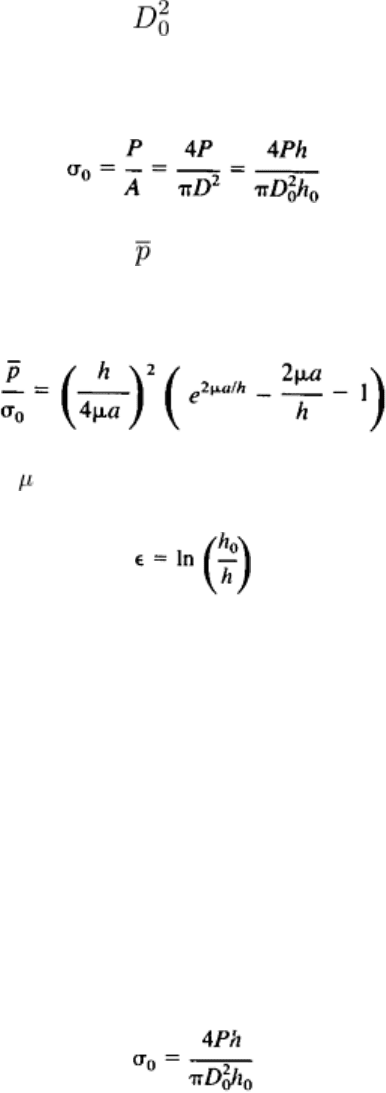
Flow Stress in Compression. Ideally, the determination of flow stress in compression should be carried out under
isothermal conditions (no die chilling) at a constant strain rate and with a minimum of friction in order to minimize
barreling. These conditions can be met with conventional servohydraulic testing machines. For an essentially
homogeneous upsetting test, a cylinder of diameter D
0
and initial height h
0
, will be compressed to height h and spread out
to diameter D
1
according to the law of constancy of volume:
h
0
= D
2
h
If friction can be neglected, the uniaxial compressive stress (flow stress) corresponding to a deformation force P is:
If substantial friction is present, the average pressure, , required to deform the cylinder is greater than the flow stress of
the material, σ
0
:
where a is the radius of the cylinder, and is the Coulomb coefficient of friction. The true compressive strain is given by:
The effects of friction and die chilling can be minimized through the use of a long, thin specimen. Therefore, most of the
specimen volume is unaffected by the dead-metal zones at the platens. However, this approach is limited, because
buckling of the specimen will occur if h/D exceeds about 2.
An extrapolation method involves testing cylinders of equal diameters but varying heights so that the D
0
/h
0
ratio ranges
from about 0.5 to 3.0 (Ref 11). A specific load is applied to the specimen, the load is removed, and the new height is
determined in order to calculate a true strain. Upon relubrication, the specimen is subjected to an increased load,
unloaded, and measured. The cycle is then repeated.
The same test procedure is followed with each specimen so that the particular load levels are duplicated. The results are
illustrated in Fig. 6. For the same load, the actual strain (due to height reduction) is plotted against the D
0
/h
0
ratio for each
test cylinder. A line drawn through the points is extrapolated to a value of D
0
/h
0
= 0. This would be the anticipated ratio
for a specimen of infinite initial height for which the end effects would be restricted to a small region of the full test
height. The true stress corresponding to each of these true strains is given by:
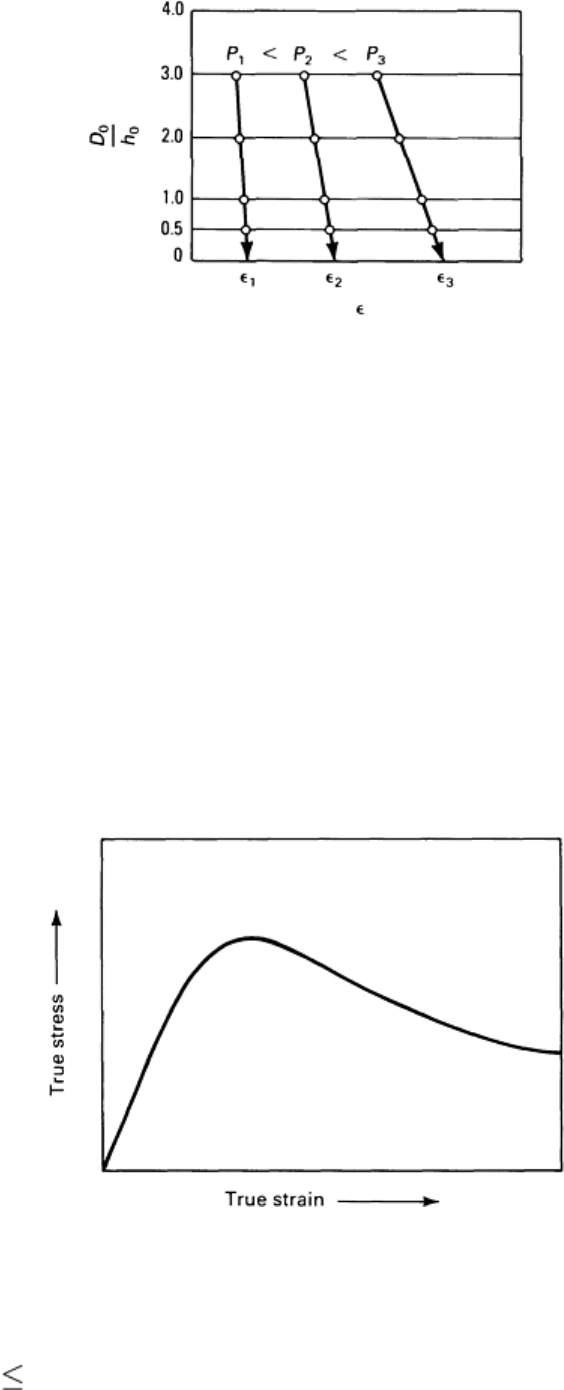
Fig. 6 Extrapolation method to correct for end effects in compressive loading. Source: Ref 11.
Ductility Testing. The basic hot ductility test consists of compressing a series of cylindrical or square specimens to
various thicknesses, or to the same thickness with varying specimen length-to-diameter (length-to-width) ratios. The limit
for compression without failure by radial or peripheral cracking is considered to be a measure of workability. This type of
test has been widely used in the forging industry. Longitudinal notches are sometimes machined into the specimens
before compression, because the notches apparently cause more severe stress concentrations, thus providing a more
reliable index of the workability to be expected in a complex forging operation.
Plastic Instability in Compression. Several types of plastic instabilities can be developed in the compression test.
The first type is associated with a maximum in the true stress-strain curve. The second type concerns inhomogeneous
deformation and shear band formation. Figure 7 shows the type of plastic instability that occurs in some materials in hot
compression testing. At certain temperatures and strain rates, some of the typical strengthening mechanisms become
unstable. Because the rate of flow softening exceeds the rate of area increase as the specimen is compressed, a maximum
results in the flow stress curve.
Fig. 7 Example of compressive flow stress curve showing strain softening.
Analysis of the compression process indicates that the plastic deformation is stable (no maximum in the flow
curve) as long as (γ + m) 1, where γ is the dimensionless work-hardening coefficient, and m is strain rate sensitivity.
Both of these material parameters are defined below (Ref 12, 13). A material with a high strain rate sensitivity is more
resistant to flow localization in the tension test (necking), but in compression testing, a higher rate sensitivity leads to
earlier flow localization.
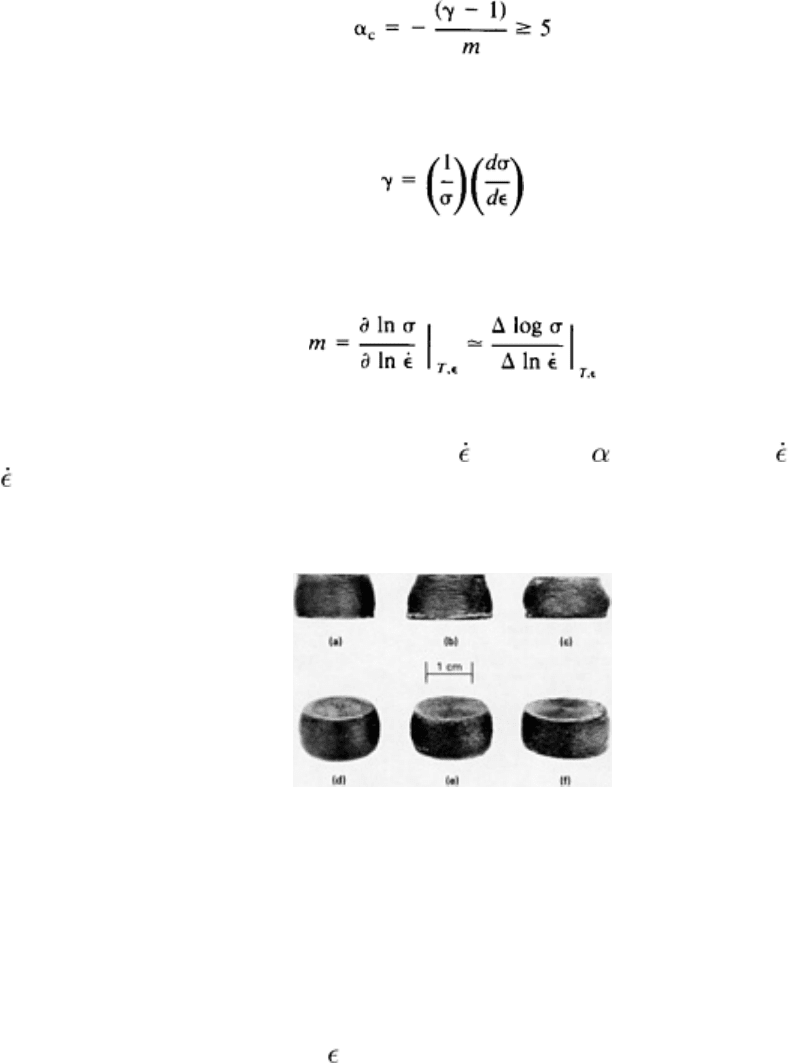
Flow softening or negative strain hardening can also produce flow localization effects in compression independently of
the effects of die chilling or high friction. The constant strain rate, isothermal hot compression test is useful for detecting
and predicting flow localization. Nonuniform flow in compression is likely if a flow parameter α
c
exceeds a certain value:
where
and
Figure 8 illustrates the differences in deformation of titanium alloy samples. The specimens in Fig. 8(a) to (c) were
deformed at a temperature at which α
c
was high. In Fig. 8(a), = 10
-3
s
-1
and
c
= 2. In Fig. 8(b), = 10
-1
s
-1
and α
c
= 5. In
Fig. 8(c), = 10 s
-1
and α
c
= 5. However, the specimens in Fig. 8(d) to (f) were deformed at a temperature at which α
c
was
less than 0.
Fig. 8 Specimens of Ti-10V-2Fe-3Al from isothermal hot compression tests.
(a) to (c) Tested at 704 °C (1300
°F). (d) to (f) Tested at 816 °C (1500 °F). Strain rates were 10
-3
s
-1
(a, d), 10
-1
s
-1
(b, e), and 10 s
-1
(c, f).
Before testing, the alloy had been β annealed to yield an equiaxed β starting microstructure. Source: Ref 14.
The bend test is useful for assessing the workability of thick sheet and plate. Generally, this test is most applicable to
cold-working operations. Figure 9 shows a plate deformed in three-point bending. The principal stress and strains
developed during bending are defined in Fig. 10. The critical parameter is width-to-thickness ratio (w/t). If w/t > 8,
bending occurs under plane-strain conditions (
2
= 0) and σ
2
/σ
1
= 0.5. If w/t > 8, the bend ductility is independent of the
exact w/t ratio. If w/t < 8, then stress state and bend ductility depend strongly on the width-to-thickness ratio.
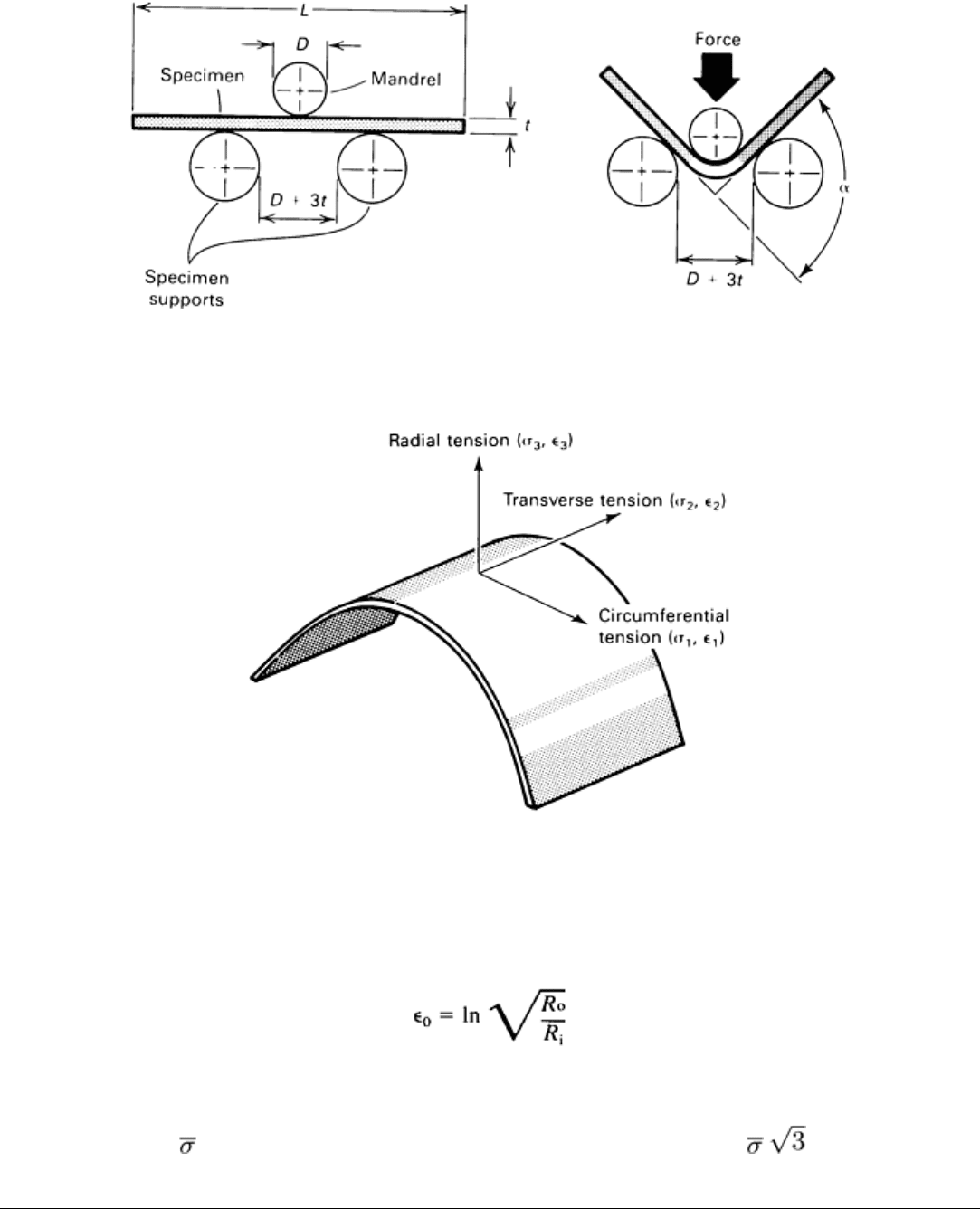
Fig. 9 Three-point bend test.
Fig. 10 Schematic of the bend region defining direction of principal stresses and strains.
For pure plastic bending, in which elastic deformation can be ignored, the maximum tensile fiber strain is (Ref 15):
where R
o
is the radius of curvature on the outer (tensile) surface and R
i
is the radius of curvature on the inner
(compressive) surface. When this strain is entered into the stress-strain equation or curve for the material, it gives the flow
stress for the material . Because of the plane-strain condition, the maximum fiber stress is 2 / .
References cited in this section
1. G.E. Dieter, Mechanical Behavior of Materials Under Tension, in Mechanical Testing,
Vol 8, 9th ed.,
Metals Handbook, American Society for Metals, 1985, p 20-27

2.
S.L. Semiatin, G.D. Lahoti, and J.J. Jonas, Application of the Torsion Test to Determine Workability, in
Mechanical Testing, Vol 8, 9th ed., Metals Handbook, American Society for Metals, 1985, p 154-184
3. M.J. Luton, Hot Torsion Testing, in Workability Testing Techniques,
G.E. Dieter, Ed., American Society for
Metals, 1984, p 95-133
4. S. Fulop, K.C. Cadien, M.J. Luton, and H.J. McQueen, J. Test Eval., Vol 5, 1977, p 419
5. J.A. Schey, T.R. Venner, and S.L. Takomana, Shape Changes in the Up-setting of Slender Cylinders,
J.
Eng. Ind. (Trans. ASME), Vol 104, 1982, p 79
6.
G. Fitzsimmons, H.A. Kuhn, and R. Venkateshwar, Deformation and Fracture Testing for Hot Working
Processes, J. Met., May 1981, p 11-17
7. J.F. Alder an
d V.A. Phillips, The Effect of Strain Rate and Temperature on the Resistance of Aluminum,
Copper and Steel to Compression, J. Inst. Met., Vol 83, 1954-1955, p 80-86
8. F.J. Gurney and D.J. Abson, Heated Dies for Forging and Friction Studies on a Modified
Hydraulic Forge
Press, Met. Mat., Vol 7, 1973, p 535
9. J.E. Hockett, The Cam Plastometer, in Mechanical Testing, Vol 8, 9th ed., Metals Handbook,
American
Society for Metals, 1985, p 193-196
10.
J.G. Lenard, Development of an Experimental Facility for S
ingle and Multistage Constant Strain Rate
Compression, J. Eng.Mater. Technol. (Trans. ASME), Vol 107, 1985, p 126-131
11.
A.B. Watts and H. Ford, On the Basic Yield Stress Curve for a Metal, Proc. Inst. Mech. Eng.,
Vol 169,
1955, p 1141-1149
12.
J.J. Jonas, R.A. Holt, and C.E. Coleman, Plastic Stability in Tension and Compression, Acta Metall.,
Vol
24, 1976, p 911
13.
S.L. Semiatin and J.J. Jonas,
Formability and Workability of Metals: Plastic Instability and Flow
Localization, American Society for Metals, 1984
14.
S.L. Semiatin, Workability in Forging, in Workability Testing,
G.E. Dieter, Ed., American Society for
Metals, 1984, p 197-247
15.
P. Dadras, Stress-Strain Relationships in Bending, in Mechanical Testing, Vol 8, 9th ed., Metals Handbook,
American Society for Metals, 1985, p 118-124
Workability Tests
George E. Dieter, University of Maryland
Specialized Tests
In the plane-strain compression test, the difficulties encountered with bulging and high friction at the platens in
the compression of cylinders can be minimized (Ref 11). As shown in Fig. 11, the specimen is a thin plate or sheet that is
compressed across the width of the strip by narrow platens that are wider than the strip. The elastic constraints of the
undeformed shoulders of material on each side of the platens prevent extension of the strip in the width dimension; hence
the term plane strain.
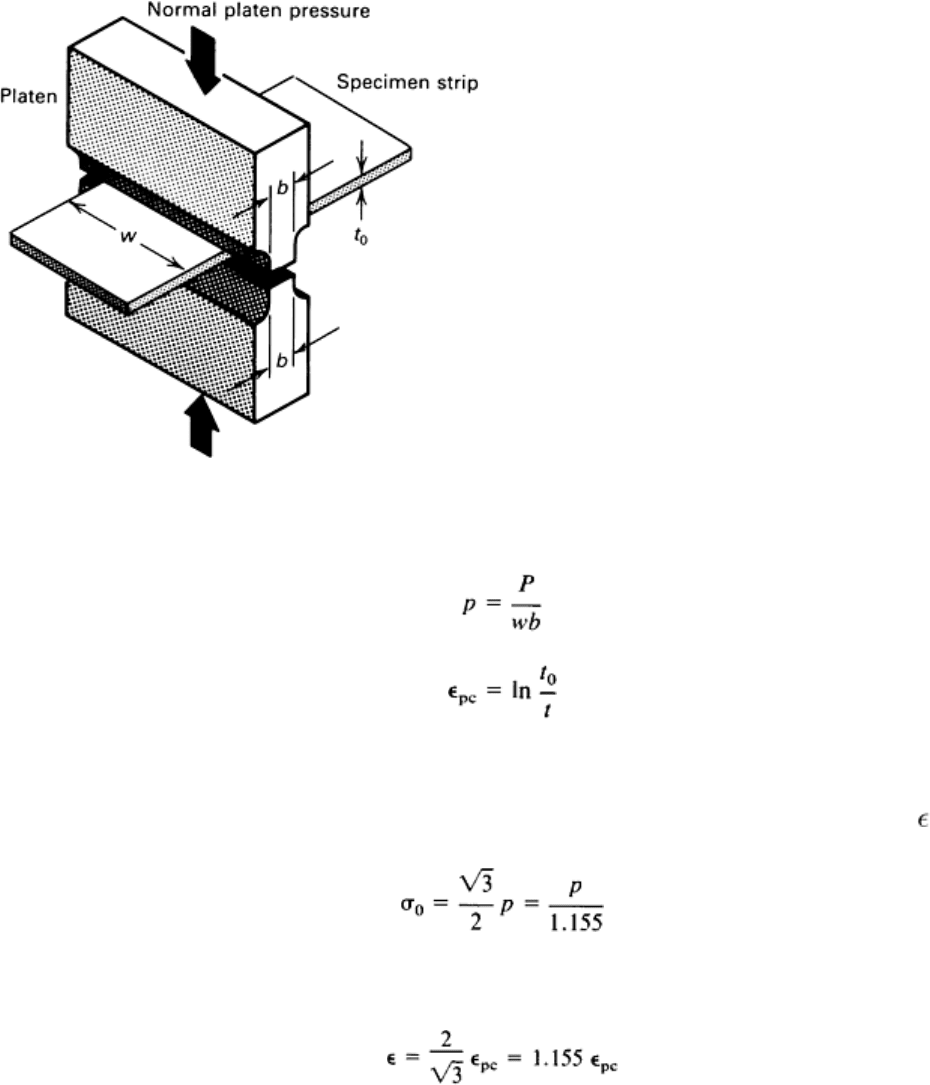
Deformation occurs in the direction of platen motion and
in the direction normal to the length of the platen. To
ensure that lateral spread is negligible, the width of the
strip should be at least six to ten times the breadth of the
platens. To ensure that deformation beneath the platens
is essentially homogeneous, the ratio of platen breadth to
strip thickness (b/t) should be between 2 and 4 at all
times. It may be necessary to change the platens during
testing to maintain this condition. True strains of 2 can
be achieved by carrying out the test in increments in
order to provide good lubrication and to maintain the
proper b/t ratio. Although the plane-strain compression
test is primarily used to measure flow properties at room
temperature, it can also be used for elevated-temperature
tests (Ref 16, 17).However, because of its geometry, this
test is more applicable to rolling operations than to
forging.
The true stress and true strain determined from the
plane-strain compression test can be expressed as:
Because of the stress state associated with plane-strain deformation, the mean pressure on the platens is 15.5% higher in
the plane-strain compression test than in uniaxial compression testing. The true stress-strain curve in uniaxial
compression (σ
0
versus ε) can be obtained from the corresponding plane-strain compression curve (p versus
pc
) by:
and
The partial-width indentation test is a new test for evaluating the workability of metals. It is similar to the plane-
strain compression test, but it does not subject the test specimen to true plane-strain conditions (Ref 18). In this test, a
simple slab-shaped specimen is deformed over part of its width by two opposing rectangular anvils having widths smaller
than that of the specimen.Upon penetrating the workpiece, the anvils longitudinally displace metal from the center,
creating overhangs (ribs) that are subjected to secondary, nearly uniaxial tensile straining. The material ductility under
these conditions is indicated by the reduction in the rib height at fracture. The test geometry has been standardized (Fig.
12).
Fig. 11 Plane-strain compression test.
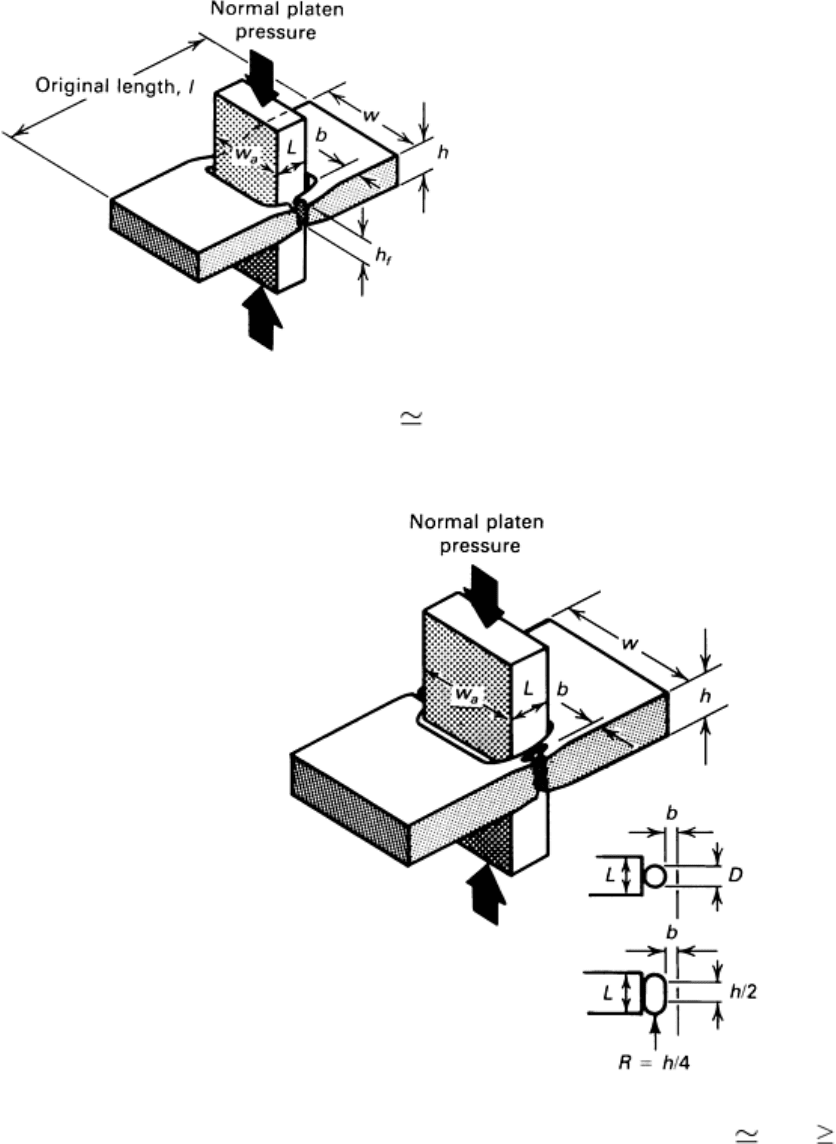
One advantage of this test is that it uses a specimen of simple
shape. In addition, ascast materials can be readily tested. One edge
of the specimen can contain original surface defects. The test can
be conducted hot or cold. Therefore, the partial-width indentation
test is suitable not only for determining the intrinsic ductilities of
materials but also for evaluating the inhomogeneous aspects of
workability. This test has been used to establish the fracture-limit
loci for ductile metals (Ref 19).
The secondary-tension test, a modification of the partial-
width indentation test, imposes more severe strain in the rib for
testing highly ductile materials. In this test, a hole or a slot is
machined in the slab-type specimen adjacent to where the anvils
indent the specimen. Preferred dimensions of the hole and slot are
given in Fig. 13. With this design, the ribs are sufficiently
stretched to ensure fracture in even the most ductile materials. The
fracture strain is based on reduction in area where the rib is cut out,
so that the fracture area can be photographed or traced on an
optical comparator.
Fig. 13 Secondary-tension test showing the geometries of holes and slots L h; w
a
2h; b = h/4; D = h/2.
Ring Compression Test. When a flat ring-shaped specimen is upset in the axial direction, the resulting change in
shape depends only on the amount of compression in the thickness direction and the frictional conditions at the die/ring
interfaces. If the interfacial friction were zero, the ring would deform in the same manner as a solid disk, with each
element flowing outward radially at a rate proportional to its distance from the center.
In the case of small, but finite, interfacial friction, the outside diameter is smaller than in the zero-friction case. If the
friction exceeds a critical value, frictional resistance to outward flow becomes so high that some of the ring material flows
inward to the center. Measurements of the inside diameters of compressed rings provide a particularly sensitive means of
studying interfacial friction, because the inside diameter increases if the friction is low and decreases if the friction is
higher (Fig. 14).
Fig. 12 Partial-width indentation test. L h; b
= h/2 w
a
= 2L; l = 4L.
